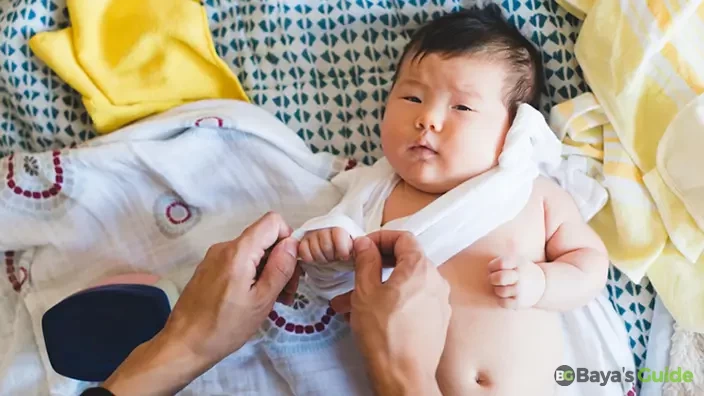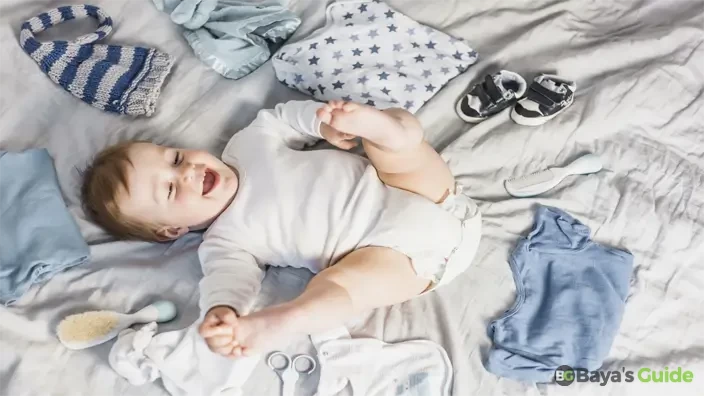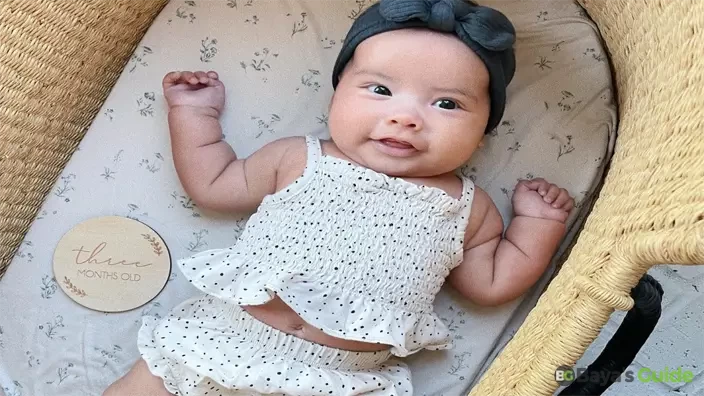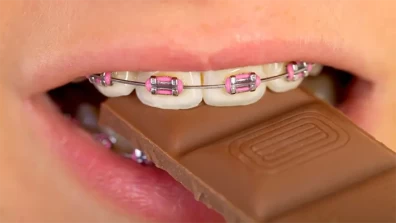Ensuring your newborn stays comfortable in the warm embrace of summer requires thoughtful consideration of their clothing choices. As a parent, navigating the delicate balance between keeping your baby cool and protected can be a challenge.
Do you have any idea about the baby’s body temperature and how difficult it is to regulate it with the temperature of the environment? This is the reason; you find it hard to adjust your baby’s clothing whether they are overheating, nor do they feel too cold. In the hot summer season, you try your best to cover your newborn with appropriate dresses that should be soft, mild, and offensive for soft baby skin while protecting him from the severe hitting weather.
In this guide, we'll explore essential tips and guidelines on how to dress your newborn during the sunny days of summer, ensuring they stay snug, stylish, and safe in the seasonal warmth.
Table of Contents
- The Temperature Of Newborn Babies
- Identifying Signs Of Heat Stress In Infants
- Dressing Your Baby For Warm Weather At Home
- Outdoor Essentials: Dressing Your Newborn for Summer
- Dressing Your Newborn For Summer Nights
- 1- Dress Your Newborn Simply
- 2- Lightweight Sleep Attire
- 3- Nighttime Comfort: Long-Sleeved/Footed Attire
- 4- Room Ventilation
- 5- Light Bedding Options
- 6- Use A Lightweight Blanket, Swaddle OR Sleep Sack
- 7- Climb Cotton Mittens to Your Baby’s Hands.
- 8- Keep Your Newborn's Head Unwrapped
- 9- Temperature Monitoring
- 10- Hydration
- Safety Tips For Baby Clothing In Hot Summer
- Frequently Asked Questions
- Which Fabrics Are Best For Newborns In The Summer?
- How Often Should I Change My Newborn's Clothes In The Summer?
- Do Newborns Need To Be Covered In Summer?
- Are There Any Particular Colors That Are Best For Newborns In The Summer?
- What Should Newborns Wear In The Summer?
- What Attire Is Suitable For Newborns In A Heatwave?
- Conclusion
The Temperature Of Newborn Babies
Based on the NHS's school of thought, normally a newborn baby's body temperature is around 36.4C, With a slight difference of 38C over a high temperature. In the real sense, the ideal temperature that a newborn can bear is around 20–22C. So, the most significant thing is to keep your baby in a room that can provide him comfortable even in hot weather.
By touching the skin of your newborn, you can easily identify the temperature. If the skin is reddened or he is having trouble while sleeping. Signs that your newborn may be too hot include flushed or red skin, sweating, rapid breathing, and fussiness. Feel your baby's neck or the back to check for overheating. If the skin feels hot or sweaty, it's a sign they might be too warm. Keep the room comfortably cool and dress your baby in light, breathable layers to help regulate their body temperature.
Dressing Your Baby For Warm Weather At Home
In hot weather, dress your newborn in light, breathable clothing such as onesies or lightweight cotton rompers. Avoid overdressing, and opt for loose-fitting garments. Keep the room well-ventilated and use a fan if necessary. Use a lightweight swaddle or a muslin blanket for naps, ensuring your baby stays comfortable without overheating. Regularly check your baby's neck or back to ensure they aren't too warm. Always prioritize your newborn's comfort in hot weather.
1- Go Natural
Every fabric is not appropriate for hot weather polyester, silk, or jersey. These are the materials that make it hard for the baby to breathe in a stifling and sultry environment. So you need to go to natural materials made of cotton for dressing your baby. Organic cotton fabric is considered light and feels breezy on your baby’s skin. Plus, they are designed with moisture-wicking to suck out the sweat from the baby’s body and leave no soggy bottom.
2- Keep Clothing Short
If you are suffering from hot severe weather, you can comfort your baby by putting him on short sleeves and short bottoms which can also protect him from the sensitivity, inflammatory effect, or skin irritation caused by a fraction.
3- Light Layers For Comfort
Dress your newborn in breathable, lightweight layers like onesies or cotton rompers to ensure optimal comfort in the warmth of your home.
4- Avoid Overdressing
Resist the temptation to overdress your baby. Opt for loose-fitting garments to help regulate body temperature and prevent overheating.
5- Keeping Newborn Feet Free
The head and feet are the most important organs which receive weather influence earlier than other body parts. So, leave your newborn barefoot while lying on his bed to get him to regulate the temperature. Furthermore, the newborns need not walk so it’s better to let them stay with no socks and no shoes. They feel comfortable and blissful with free feet wriggling their toes. However, if you baby steps or promenades a little, you can go for open sandals to let them walk with a dreamy breeze tickle.
6- Well-Ventilated Spaces
Keep your home well-ventilated. Open windows or use fans to maintain a comfortable environment for your newborn during hot weather.
7- Swaddle With Care
If you choose to swaddle, use a lightweight swaddle or muslin blanket. Ensure it allows proper airflow to prevent overheating during naps.
8- Slinging Safely
If you are a mama who is a sling-wearer, avoid your baby covering it inside or wrapping it with it as it is exceptionally hot for your baby's skin. Being used to sling-wearing, you need to opt for a breathable material to keep yourself & your baby cooler.
9- Sleeping Safely
The temperature affects your baby’s body when he comes to sleep, the room temperature is usually above 20c. At this level of room temperature, you should dress your newborn in a 0.5 TOG sleep sack, short sleeves, and short-sleeve bodysuit. Never ignore providing him with a place hotter than 25c while you are forgoing him in the sleeping bag.
Now the question arises of what type of dress your baby needs, you may determine by looking at what you have worn at the time of sleep. Generally, babies have the body temperature same alike as adults. It's better to monitor the room's temperature and the toddler's body temperature and then adjust his clothes accordingly or somehow you can give him an extra layer.
Prior Tip: By touching the back and neck of your baby, you can easily identify the temperature of your toddler whether he is hot or cold.
10- Regular Temperature Checks
Monitor your baby's comfort by regularly checking the back of their neck. If they feel too warm or sweaty, adjust their clothing accordingly to maintain an ideal temperature.
11- Keeping Your Newborn Hydrated
Ensure your newborn stays well-hydrated. Dressing them appropriately, combined with adequate fluids, helps keep them cool and content in hot weather.
Recommended Reading: How To Use A Bar Of Soap
Outdoor Essentials: Dressing Your Newborn for Summer
Dress your newborn for hot weather outside by choosing lightweight, breathable clothing, such as onesies and hats for sun protection. Keep them cool in shaded areas, apply baby-friendly sunscreen on exposed skin, and ensure they stay hydrated with regular feedings. Prioritize comfort and sun safety during outdoor activities.
Remember, these guidelines are general recommendations, and it's crucial to observe your baby's cues to tailor their dressing to individual comfort levels.
1- Sun-Safe Attire
Choose clothing that provides sun protection, such as lightweight, long-sleeved onesies and wide-brimmed hats to shield your newborn from the sun's rays.
2- Light- Colored Dress
Opting for light-colored clothing for your newborn in summer is a smart choice. Light colors, like light blue, greenish, or pinky shade reflect sunlight and help to keep your baby cooler by absorbing less heat. This, in turn, contributes to a more comfortable outdoor experience for your little one in warmer weather.
3- Light Socks
It's generally advisable to skip socks for your newborn in hot summer weather, as bare feet can aid in regulating their body temperature and prevent overheating. If you feel the need for foot covering, opt for lightweight and breathable socks to ensure your baby's comfort during outdoor activities.
4- Extra Protection With a Hat & Glasses
On the days when you are facing the sun persistently, you need to provide your baby with extra protective measures. Holding a hat with a brim on your baby’s head offers sure protection from the sunrays to shield your baby’s face. The eyes are considered the most delicate part of the body which hurriedly gets affected by the sun, hot wind or dusty articles present in the hot summer air, So if you are looking for a hot bright sunny day, it's essential to send your baby out with UV protection sunglasses on eyes.
5- Use Breathable Fabric
Opt for breathable fabrics like cotton to keep your baby cool and comfortable in the summer heat when you're outside.
6- Avoid Tight-Fitting Clothing
Indeed, avoiding tight-fitting clothing for your newborn in hot summer weather is essential. Loose and breathable garments help regulate body temperature and prevent discomfort or overheating. Prioritize comfort by choosing airy outfits that allow for easy movement and airflow during outdoor activities.
7- Sunscreen Application
If your baby is exposed to direct sunlight, apply a baby-friendly sunscreen to the exposed skin, following the product's guidelines for infants.
8- Shade Seeking
Seek shaded areas when outdoors. Whether it's under a stroller canopy or a sun umbrella, providing shade is crucial to prevent overheating.
9- Hydration Essentials
Keep your baby well-hydrated, especially in warm weather. Offer frequent feedings if you're breastfeeding or have formula on hand when you're out.
10- Lightweight Stroller Blankets
Use lightweight blankets in the stroller to shield your newborn from the sun or provide a bit of warmth if there's a breeze.
Remember to adjust your baby's attire based on specific outdoor conditions and always prioritize their comfort and safety in the summer weather.
Dressing Your Newborn For Summer Nights
Ensuring your newborn is appropriately dressed during sleep in summer is crucial for their well-being. Lightweight and breathable sleep attire helps regulate their body temperature, preventing overheating and ensuring a comfortable night's rest.
Adequate ventilation in the sleeping area further contributes to a conducive sleep environment. By dressing your baby in weather-appropriate sleepwear, you minimize the risk of discomfort, promote better sleep quality, and support their overall health and development during the warm summer nights. Monitoring their clothing choices during sleep becomes a key aspect of providing a safe and nurturing atmosphere for your newborn.
1- Dress Your Newborn Simply
A simple dress is needed when your newborn is not sleeping in an air-conditioned room. If your room temperature is higher than75 °F (24 °C), you must put your toddler on with a single-layer dress of light color to make him sleep restfully. With a temperature lower than 75 °F (24 °C), you need to give your baby an extra layer of clothing.
Prior Tip:
- Always run the pedestal on the opposite side of the place where the baby is sleeping which will cool the room without disturbing the baby in sleep.
- Keep Your room between 68 to 72°F to provide your baby with more comfortable sleep.
2- Lightweight Sleep Attire
Choose lightweight sleepwear like breathable onesies or cotton rompers to keep your newborn cool and comfortable during summer nights.
3- Nighttime Comfort: Long-Sleeved/Footed Attire
Avoid your newborn short clothing at night if your room is air-conditioned. Put your baby in long cotton pajamas. Also, provide him with a lightweight swaddle when you find the temperature too cold.
After a few weeks of your childbirth, you will understand the atmosphere your baby likes the best at nighttime.
4- Room Ventilation
Ensure the sleeping area is well-ventilated. Use fans or open windows to maintain a comfortable temperature for your baby.
Opt for light and breathable bedding, such as muslin blankets, to provide a cozy yet ventilated sleep environment.
6- Use A Lightweight Blanket, Swaddle OR Sleep Sack
Dress your toddler with a bodysuit to give him a snap closure determining the room temperature. Avoid covering his face and feet as it irritates him in sleep. Also, avoid a free blanket to cover your toddler as it may accidentally cover the baby’s face it can stifle him in sleep.
7- Climb Cotton Mittens to Your Baby’s Hands.
Most often the babies get their faces scratched due to their short sharp nails as they don’t know how to protect themselves from their nails. Wear cotton mittens to their hands which stay fit to their thumb and fingers separately. The mittens should be fit enough to cover their hands tightly and not be removed on their own at night.
8- Keep Your Newborn's Head Unwrapped
Keeping a newborn's head uncovered during summer nights is important for effective temperature regulation. Babies dissipate heat primarily through their heads, and leaving their heads uncovered allows for better heat exchange. This helps prevent overheating, a concern, especially during warmer nights. Additionally, maintaining proper airflow around the head helps in regulating body temperature, reducing the risk of sudden infant death syndrome (SIDS). By keeping the newborn's head uncovered, you promote a safe sleep environment, ensuring they stay comfortably cool throughout the night.
9- Temperature Monitoring
Regularly check the room temperature to ensure it's suitable for your baby's sleep. Aim for a comfortable and consistent sleeping environment.
10- Hydration
Keep your baby well-hydrated during the day, as this contributes to their overall comfort and may aid in a more restful sleep at night. Remember, each baby is unique, so observe your newborn's cues to tailor their sleep attire and environment to their individual needs.
Safety Tips For Baby Clothing In Hot Summer
- Ensure your baby stays well-hydrated by offering frequent feedings, whether through breastfeeding or formula, to prevent dehydration during hot summer days.
- Shield your baby from direct sunlight by using lightweight clothing, wide-brimmed hats, and seeking shade when outdoors. Apply baby-friendly sunscreen to exposed skin.
- Keep your baby's environment well-ventilated, whether at home or in the car, to prevent overheating. Use fans or air conditioning as needed.
- Dress your baby in lightweight, breathable clothing to help regulate body temperature. Avoid tight-fitting outfits to ensure comfort.
- Follow safe sleep guidelines by placing your baby on their back to sleep and ensuring the sleeping area is free of heavy bedding, toys, or excessive warmth.
- Never leave your baby unattended in a parked car, even for a short time. Cars can quickly become dangerously hot, posing a severe risk of heat-related issues.
- Be vigilant for signs of overheating, including flushed skin, sweating, rapid breathing, and fussiness. Adjust your baby's clothing or environment accordingly.
- Monitor the room temperature and your baby's body temperature to ensure they are comfortable and not excessively warm.
- By incorporating these safety tips, you can help keep your baby comfortable, cool, and safe during the heat of summer.
Frequently Asked Questions
Which Fabrics Are Best For Newborns In The Summer?
Soft light natural fabrics such as cotton, bamboo, and muslin are considered the most appropriate dresses for babies. The clothes made of this stuff are breathable, moist absorbable, and protect your baby’s skin from inflammation or irritation.
How Often Should I Change My Newborn's Clothes In The Summer?
During the summer months, it's advisable to change your newborn's clothes as needed to ensure they stay cool and comfortable. Factors such as temperature, humidity, and your baby's activity level can influence how frequently you should change their attire.
In hot weather, if your baby sweats or if their clothes become damp, it's beneficial to change them promptly to prevent overheating and skin irritation. Additionally, opting for lightweight and breathable fabrics reduces the need for frequent changes as they help regulate body temperature. Regular checks for signs of discomfort, like sweating or warmth, will guide you in determining the appropriate frequency of clothing changes to maintain your newborn's well-being in the summer heat.
Do Newborns Need To Be Covered In Summer?
The skin of newborn babies contains light and tiny melanin to safeguard your baby’s skin from the sun. The melanin should not be revealed for your baby should put on a single-layer, breathable cotton dress. Always put on a hat with a long brim when you go out with your baby on a hot bright sunny day.
Are There Any Particular Colors That Are Best For Newborns In The Summer?
With all the precautionary measures, your baby should have lighter and pastel colors. Generally, lighter colors are recommended to safeguard your babies from the summer heat as dark colors reflect more heat than light colors. So, it’s better to use lighter colors for your newborn to keep him as comfortable as possible.
What Should Newborns Wear In The Summer?
In the summertime, dressing your newborn involves choosing lightweight, breathable clothing to ensure comfort and prevent overheating. Opt for onesies, rompers, or soft cotton outfits that allow air circulation, keeping your baby cool. Wide-brimmed hats provide shade and protect their delicate skin from the sun. Avoid overdressing and opt for loose-fitting garments to help regulate body temperature. When going outdoors, use a baby-friendly sunscreen on exposed skin and keep your newborn shaded.
What Attire Is Suitable For Newborns In A Heatwave?
During a heatwave, it's crucial to keep your newborn cool and comfortable while sleeping. Dress them in lightweight, breathable sleepwear such as a loose-fitting onesie or a diaper. It's advisable to avoid heavy blankets or quilts and to check your baby's temperature by feeling their neck to ensure they are not too warm. Creating a comfortable and cool sleep environment is key to ensuring your newborn sleeps safely during a heatwave.
Conclusion
In conclusion, dressing a newborn in summer involves prioritizing their comfort and safety in warmer temperatures. Choose lightweight, breathable clothing like onesies or rompers to help regulate their body temperature. Opt for light-colored fabrics to reflect sunlight and prevent overheating. Keep the environment well-ventilated, both during sleep and outdoor activities. Use wide-brimmed hats and baby-friendly sunscreen for sun protection. Regularly monitor your baby for signs of overheating, adjusting their clothing accordingly. Have a safe And Happy Summer!























